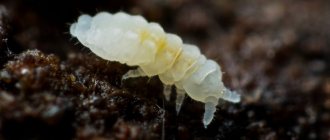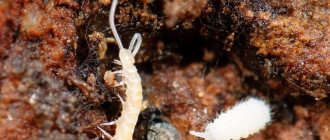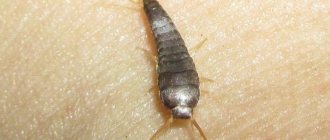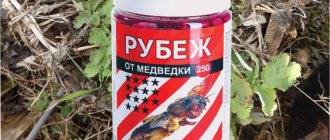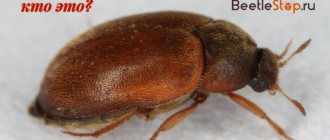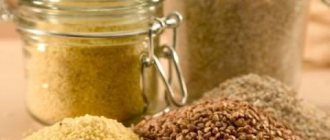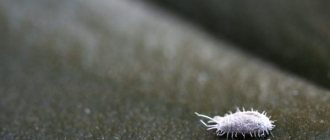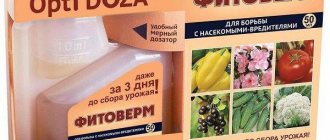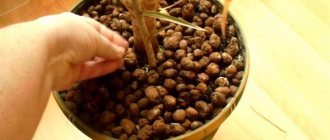Ways of bugs appearing in pots
Most often, it is white bugs that appear on indoor plants. There are a number of ways for beetles to appear in the soil:
- through an open window from the street. This happens if the larvae or adults are on trees;
- poor quality
White bugs in a pot.
the soil that was brought. This problem often arises if the soil for planting is not purchased, but collected;
- soil moisture is too high, which causes rotting;
- various midges and insects that like to lay their eggs in the ground.
No chemical attacks
Having discovered small populations of insects, you can do without the use of chemical reagents.
- When a springtail is first detected, completely immerse the entire flower along with the pot in water. The floating insects are immediately collected. The plant should not be watered. The top layer of soil (up to 40 mm thick) is removed, and clean, dry sand is poured in its place.
- If podura pests are found in a flowerpot with orchids, the plant is removed from the bark and the roots are washed well with water. The processed rhizome is planted in the whole bark. The rot is cut off and the sections are dried.
- You can dissolve 0.5 tablets of citramone (ascophen) from your home medicine cabinet in 3 liters of water. When watering flowers, use this solution.
- Place the cut potato (cut side down) into the container with the flower. After a while, remove the vegetable along with the podurs that have penetrated into it.
- Dry lemon and orange skins and place them in pots with plants. Insects cannot stand the smell of citrus fruits and “leave.”
- Do not water the soil with a solution containing decomposing organic matter: milk, tea or coffee, etc.
- The soil and green areas are dusted with wood ash. Crushed into powder, it is sprinkled on the soil with a layer of 10 mm with scanty watering.
- Dry mustard is also used for dusting. Powder is sprinkled on the soil in a pot with a layer thickness of 10 mm with limited watering.
- Water with a solution: 40 g of grated laundry soap, pour 1 liter of water and dissolve.
- Dry mustard (10 g) is silted with water (1 l) at a temperature of 60°C. The solution is infused for 48 hours, after which it is filtered. Used for treating flower seeds before planting.
- The same mustard (1 tsp) is diluted in 1 liter of water. This is how the composition is prepared for watering and simultaneously destroying other pests.
Types of white beetles in flowers
To determine the method of combating the infestation, it is necessary to understand what type of pests attacked indoor flowers. There are a number of common white beetles that can live in the soil.
Drastic measures
Some types of bugs affect not only flowers, stems and leaves of plants, but also the root system. Therefore, if you notice that pests are present in the soil, you will need to take drastic measures. First, take a new substrate. Then remove the affected house flowers from their pots and carefully remove the soil. It is advisable to rinse them under running water. If some leaves and buds of plants are too badly damaged by bugs, then it is best to break them off.
Dilute the Aktara chemical according to the instructions on the package and spray each plant with the resulting solution. Then fill the thoroughly washed pots with new substrate and plant the treated flowers in them. Be sure to add a small amount of calcined sand on top (you can use regular ash). Water the plants with soapy water and place them on the windowsills. After a week, re-treat them with Aktara.
Remember that when using chemicals you must wear a respirator, goggles and gloves. This will protect your hands and mucous membranes from their harmful effects. The treatment itself is best done in the fresh air.
With the arrival of winter, I discovered small jumping insects in a pot of Schlumbergera. What could this be and how can I get rid of them?
You can often see small jumping insects in flower pots; gardeners call them flea beetles. Many people are interested in whether they harm plants and how to get rid of them.
These are springtails
– they are also called springtails, forktails or podars. Food for the insect is decaying plant debris and soil microorganisms. However, when the number of springtails increases, they can encroach on the delicate parts of the plant: thin feeding roots or shoots.
White flea beetles do not harm most indoor plants in flower pots, however, an increase in the number of insects may indicate that you are systematically over-watering the soil. And this is already fraught with root rot.
The development of padurs is possible only in a humid environment, so to reduce their numbers it is enough to dry the soil and replace the top layer in the pot with the plant.
Important! When replacing the top clod, do not use soil with organic matter - it serves as soil for flea beetles.
You can catch springtails using homemade baits made from pieces of raw potatoes, which are laid cut side down on the top layer of soil. The padur that accumulates on the potatoes is washed off with water. If you have an aquarium with fish, then insects are quite suitable for food.
Prevention measures
To protect indoor flowers from various insects, you need to follow a few simple rules.
- Do not over-moisten the soil; leave it to dry between waterings.
- Monitor air humidity. The room should always have an optimal level of humidity, not excess.
- Periodically inspect indoor flowers for pests. A putrid odor may also be a symptom.
- Periodically water and spray with potassium permanganate.
- All new plants brought in from the street must be quarantined for 14 days.
- When replanting, use only special, purchased soil. And it is even recommended to disinfect it, warm it up or freeze it.
- If pests are found on one of the plants, you need to treat everyone nearby.
How to get rid of earthen fleas?
Many people think that fleas appear in houses outside the city. But increasingly, harmful insects are settling in apartments. Parasites enter there through holes in the floor and are carried by pets or other people.
The main methods of fighting earth fleas are carrying out disinfestation measures, which involve the use of special aerosols, solutions, the use of folk remedies, and preventive treatment of the home.
Professional pest control
Those who do not know how to get rid of fleas in a private home should seek the help of a special service. Professional pest control is quite expensive, but it will be effective if there are many parasites living in the room.
Advantages of using insecticides by specialists:
- Harmlessness and effectiveness of the means used.
- Most companies are ready to respond to calls on holidays and weekends.
- After neutralization, the effect remains long-lasting, which does not require re-treatment.
- Many organizations provide a guarantee for their services.
- During the procedure, special equipment is used to eradicate insects forever.
Also, exterminators use special chemicals and can influence parasites through temperature effects. An effective way to destroy earthen parasites is the use of fog, when a generator sprays insecticides containing microparticles of chemicals.
Specialists also carry out manual disinfection, which allows them to treat the most inaccessible places.
After treatment, the house or apartment should be closed for 1 or 3 hours, which will allow the insecticide to have maximum effect. Then you need to open the doors and windows for at least 3 hours, and then wipe everything that household members will touch with a damp cloth.
Flea sprays
To kill earth fleas, various sprays are often used, which have an immediate effect and are easy to apply. To treat 10 m2 you will need one cylinder.
After using such products, adults die within 60 minutes. But after a couple of days, new parasites may hatch from the larvae, which requires repeated disinfestation.
Popular aerosol remedies for fleas:
- Raid;
- Combat;
- Epair;
- Dichlorvos;
- Raptor;
- Effective Ultra and others.
Aerosols or sprays must be used correctly. Before processing, you should put on a protective mask on your face and gloves on your hands. Shake the can, open the cap, press the sprayer, and hold the bottle at a distance of 20 cm from the surface.
Next, it is necessary to carry out a thorough disinfestation of carpets and upholstered furniture, baseboards, and similar places. After 15 minutes you need to ventilate the room.
The procedure can be repeated after 30 days to destroy the hatched parasite larvae. After 4 hours, furniture and surfaces must be wiped, and the floor can be washed only after 5 days.
Solutions against parasites
Those who are wondering how to remove fleas from a large area should use special insecticide concentrates. These products are odorless; the instructions for use state that they are diluted with water and then poured into a spray bottle.
It is noteworthy that this method of disinfestation is much more economical than the use of aerosols.
The best means to combat basement fleas:
| Name of solution | Concentration | Features of application |
| Agran | 0.137% (according to Far East) | The emulsion is used to treat walls (up to 1 m in height), carpets, baseboards, and cracks. The product can be used for disinfestation in basements, private houses, and apartments after preliminary cleaning of the premises. |
| Cifox | You will need 4 ml of concentrate per bucket of water. | When the solution is infused, using a brush, you need to apply it to the walls and floors. |
| Delta zone | 100 ml/m2 – soft, uneven surfaces, 50 ml/m2 – for walls, floors | All surfaces are treated with the solution and the room is left closed for 2-3 hours. Next, the rooms are ventilated. |
The antiparasitic effect of the above agents lasts about 3 weeks. If necessary, repeated disinfestation measures are carried out in compliance with all rules.
Folk remedies for removing fleas
At home, you can kill earth fleas yourself using folk remedies. A simple, affordable recipe against parasites involves the use of salt and soda.
The components are mixed (1:1). The mixture is scattered over baseboards, floors, corners, and rubbed into soft areas. After a day, surfaces that have been disinfested must be vacuumed.
Similarly, you can use a mixture of yeast and garlic, borax powder.
An effective, affordable way to kill fleas is kerosene. 100 ml of the product is mixed with a bucket of water. The solution is sprayed throughout all rooms, and then all windows and doors are closed. After 4 hours, the room is thoroughly cleaned, preferably wet.
You can also place herbs around the house whose smell insects do not like. These are eucalyptus, tansy, pine needles, wormwood.
In the fight against harmful insects, you can use wormwood and mint:
- mint leaves (20 g), wormwood (10 g) are steamed with 200 ml of boiling water.
- The broth is left for 10-12 hours.
- The entire room is treated with the product.
For earthen fleas, wormwood (400 g), eucalyptus, and tansy (200 g each) are used. The raw materials are crushed, steamed with boiling water (200 ml), and left for 24 hours. The infusion is filtered, poured into a spray bottle, and then all places where insects live are treated with it.
Video
How to get rid of fleas using GET Total?
Traditional medicines against parasites
Folk remedies are often used to get rid of fleas. You shouldn’t rely too much on them, as they mostly have a deterrent effect. The most popular plants: mint, wormwood, tansy, bay leaf, chamomile. Fresh or dry twigs are laid out indoors, you can prepare decoctions and treat floors, furniture, and walls with them.
Ammonia, vinegar, and aromatic oils are added to the water for washing floors. Placing citrus peels around the perimeter of the house will help repel bloodsuckers. Garlic has a pronounced repellent effect, and in combination with brewer's yeast, it causes parasites to quickly leave their habitats.
Preventive measures
These simple preventative measures will help prevent fleas from breeding in your home. They are especially relevant for those who have a cat or dog at home:
- carry out serious wet cleaning as often as possible;
- Ventilate the room at least twice a day;
- kill all rodents located near your home and protect the house from them;
- after visiting a basement, river, hunting, etc. Always wash all clothing thoroughly;
- if no measures bring results, it is better to contact the SES.
Danger and treatment of bites
Earth fleas are dangerous for pets and people, as their bites can cause allergies, dermatitis, and severe itching. In addition, scratching itchy bites can introduce an infection into the wound.
Since fleas carry helminth eggs, by accidentally swallowing a flea, a person or animal can become infected with worms.
Cold compress
And finally, fleas are carriers of pathogens of many dangerous diseases, including:
- hepatitis;
- typhus;
- salmonellosis;
- pseudotuberculosis;
- anthrax;
- plague.
Having discovered a flea bite, it must be immediately disinfected by washing with soap and water or hydrogen peroxide. After this, the affected area should be lubricated with an antihistamine or antipruritic drug. A cold compress will help reduce discomfort and relieve swelling.
Habitats
Ground fleas, as their name suggests, live on the ground or shallow underground. They can also settle in animal burrows. If earthen fleas appear in the house, then they will first occupy the following places:
- carpets;
- cushioned furniture;
- blankets, bedspreads, soft toys;
- pet beds and houses;
- cracks in the floor, behind the baseboard.
When choosing secluded places in the apartment, fleas still prefer to be closer to the food source. That is why it is most likely to find them close to the place of the pet or on it itself.
Types of pests
Among the pests that can be generally called midges, the following varieties are distinguished:
Drosophila is a fruit, fruit or vine midge that looks like a miniature fly. It feeds on plant sap, microorganisms, and rotting debris. He loves cyperus, callas, violets, orchids, but in their absence he will not disdain any other flower.
The sciarid is a fungus gnat that actually looks like a black mosquito. The root system of the plant becomes their victim. Living there, they also greatly compact the soil, depriving the roots of oxygen. If they have a choice, they will settle in a pot with ficus, violet, azalea, aloe, and Decembrist.
The whitefly looks like a white, but very small moth. Dangerous at all stages of development. It sucks the juice from the leaves, releasing liquid like an aphid. This becomes good food for the fungi, which continue to destroy the plant. Orchid, fuchsia, roses, balsam, passionflower, pelargonium - this is not a complete list of their favorite victims.
Podura, or springtail - they can be seen on the surface of wet soil, at the foot of a plant or in a tray where there is water. They are very small (1-2 mm), fast, jumping. They feed on microorganisms and decaying organic matter, that is, they act more like insect indicators of excess watering.
But when there are more of them, they move to young white shoots of roots or underground shoots of plants, exposing them to fungal and bacterial infections. They can settle in any plant, but they prefer violets, begonias, fuchsias and orchids.
All preferences of midges are quite conditional; they will settle where there is humidity and rotting organic matter.
